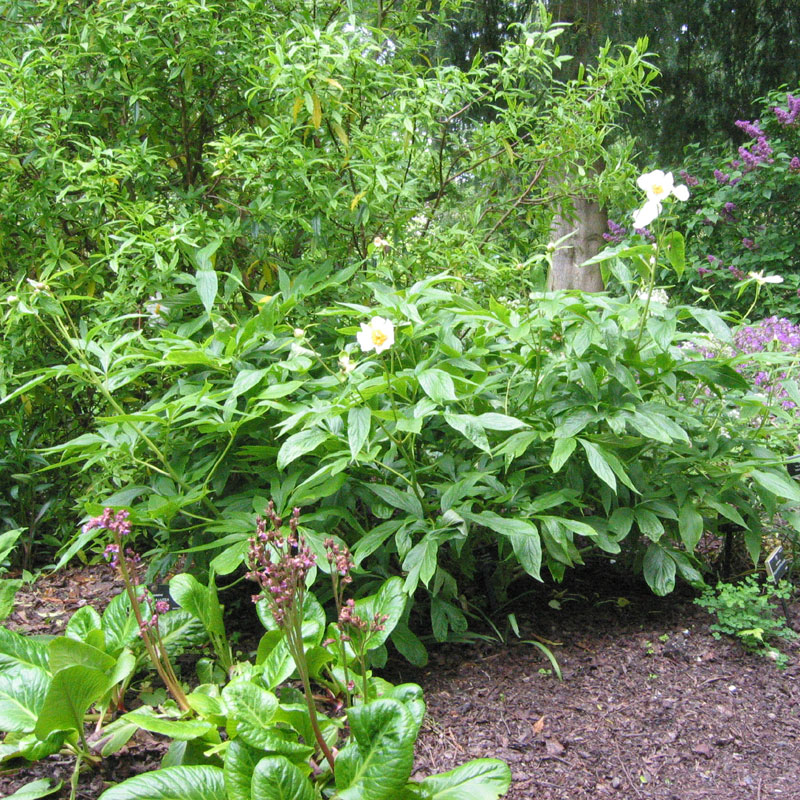accepted name
(2005)
Wallich, 1868 Paeonia emodi. Himalayan Peony, Curtis's Botanical Magazine, Tab. 5719



Stern (1946):
35. Paeonia emodi sect. PAEON SUBSECT. foliolatae lactiflora GROUP
35. P.emodi Wall. ex Royle, Ill. Bot. Himalayan Mts. 57 (1834); Wallich, " Cat." no. 4727 (1831), nomen subnudum; Bot. Mag. t. 5719 (1868) ; Hook. f., Fl. Brit. India, 1, 30 (1872) ; Baker in Gard. Chron., N. Ser. 21,829 (1884) ; Lynch in Journ. Roy. Hort. Soc. 12, 437 (1890) ; Basu, Ind. Med. PI. 1, 36, t. 23 (1918) ; Coventry, Mid Flow. Kashmir, I, 19, t. 10 (1923) ; F. C. Stern in Journ. Roy. Hort. Soc. 68, 129 (1943).
Syn. P.anomala L. var. emodi (Wall.), Huth in Engl. Bot. Jahrb. 14, 269 (1891).
P.officinalis L. sec. Hook. f. & Thorns. Fl. Ind. 60 (1855), non L. emend. Willd.
Description. Stem 30-75 cm. high, glabrous, light green, bearing two to four flowers. Lower leaves biternate ; leaflets usually decurrent and confluent at the base, entire or often deeply divided into two, or the terminal leaflet into three segments, leaflets or segments elliptic, narrowed to the base and to the acuminate apex, 12-17 cm. long, varying greatly in width from 1.5 cm. to 5.5 cm., dark green and glabrous above (very minutely puberulous along the veins), sometimes lighter green and glabrous below. Flowers 8-12 cm. across. Petals obovate, white, 4-5 cm. long, 2-4 cm. wide. Stamens about 1.5 to 2 cm. long, filaments and anthers yellow. Carpels usually one, rarely two, densely hispid, hairs yellowish. Follicles 1.5-2.6 cm. long.
Distribution. India : ------------
Paeonia emodi is a very beautiful paeony found in the United Provinces of India, Kashmir and Chitral. It is like P.lactiflora in having more than one flower to a stem and in the long leaflets up to 17 cm. long, but differs from P.lactiflora in the leaflets, which are longer and not scabrid along the margins, and in the carpel, which is nearly always solitary and densely hairy with short yellowish hairs. The flowers are always white. It is found at about 7500 feet. Huth draws attention to the presence on all the main veins on the otherwise glabrous upper side of the leaves of an uninterrupted line of delicate small hairs just visible through a lens. These are particularly visible in fresh specimens but seems to rub off on older dried specimens. P.emodi is a diploid.
P.emodi is hardy in the south of England in well protected places and seems to grow best amongst shrubs where it is protected from the early morning sun.
There is a very beautiful form of this paeony known as P.X emodoff which has been distributed from the Glasnevin Gardens in Dublin. It grows up to 100 cm. (3 ft. 4 in.) in height and makes a big bush in the garden. Sir Frederick Moore informs me that it is said to be a cross between P.officinalis alba and P.emodi and that P.officinalis alba is the female parent. Comparison with dried specimens of P.emodi and with plants raised from seed of the wild P.emodi reveals no differences except that it is larger in all its parts and grows to a greater size. Again, it comes true from seed and is a diploid like P.emodi so that it is highly improbable that it can be a hybrid with P.officinalis, a tetraploid, as its seed parent. I, therefore, conclude that it is no more than a specially robust form of P.emodi


Chris Denvir 2007


Westland:














